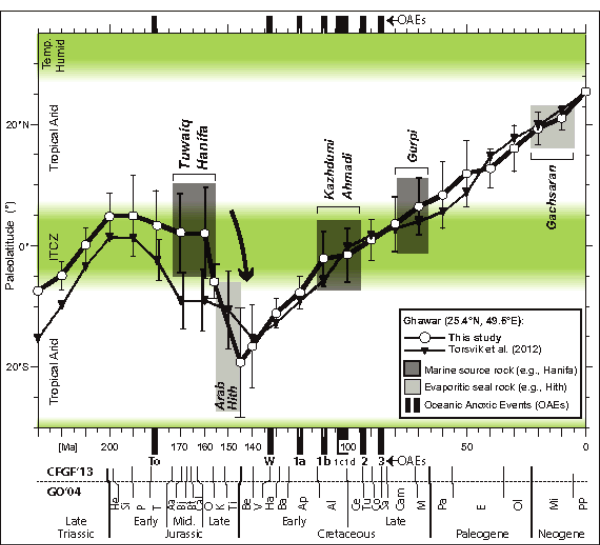
Figure 2.
The paleolatitudinal evolution curve (white circles) of Ghawar (25.4°N, 49.6°E) in the Persian Gulf of Saudi Arabia calculated from the inclination flattening-free apparent polar wander (APW) path of Table 1 (in Arabian coordinates) that incorporates the Jurassic polar shift; errors in age (not shown to enhance visual clarity of diagram) are ± 10 m.y. except for paleolatitudes at 145 and 156 Ma with errors of ± 5 and ± 1.6 m.y., respectively; errors in paleolatitude (shown as vertical bars) are equal to ± A95 (cone of 95% confidence of mean paleomagnetic pole). The black arrow highlights the latitudinal drift associated with the Jurassic polar shift. Paleolatitudes computed for Ghawar using the Torsvik et al. (2012) APW path are also reported for comparison (black triangles, with error bars at 180, 170, 160, 150 Ma). The names of main source and seal rock formations/members discussed in the text are also reported (e.g., Hanifa, Hith) together with the temporal distribution of main Oceanic Anoxic Events: To—“Posidonienschiefer” (Toarcian); W—“Weissert” (Valanginian–Hauterivian); 1a—“Selli” (Early Aptian); 1b—“Paquier” (Late Aptian–Early Albian); 1c—“Toolebuc” (Late Albian); 1d—“Breistroffer” (Late Albian); 2—“Bonarelli” (Cenomanian–Turonian boundary); and 3 (Coniacian–Santonian) (Cronin, 2010). CFGF’13—time scale of Cohen et al. (2013); GO’04—time scale of Gradstein and Ogg (2004). ITCZ—Intertropical Convergence Zone; He—Hettangian; Si—Sinemurian; P—Pliensbachian; T—Toarcian; Aa—Aalenian; Bj—Bajocian; Bt—Bathonian; Cal—Callovian; O—Oxfordian; K—Kimmeridgian; Ti—Tithonian; Be—Berriasian; V—Valanginian; Ha—Hauterivian; Ba—Barremian; Ap—Aptian; Al—Albian; Ce—Cenomanian; Tu—Turonian; Co—Coniacian; Sa—Santonian; Cam—Campanian; M—Maastrichtian; Pa—Paleocene; E—Eocene; Ol—Oligocene; Mi—Miocene; PP—Pliocene–Pleistocene.